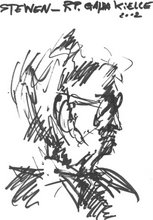I feel that food shops in Poland have changed dramatically in the past 10 to 15 years and have been considering the issue of 'quality' shops. My two problems are that the places I know may well be unrepresentative of Poland generally, and that what I take notice of and consider important may be different to other people. I've found this about England.
Jeremy Paxton's 1998 vision of English towns (presumably pre-mobile phone times) gives his perception:
A little bit of Kingston-on-Thames in 2006:

“If one [an old style, red telephone kiosk] still survives it as an ornament to a 'heritage site', as one shop after another is colonized by burger bars and pizzerias. In these places … High Streets are either jammed with cars or pedestrianized, the newly laid cobbles, wrought iron lampposts and litter bins a self-conscious imagination of how the place might have looked in Victorian days... [Comment on city centres in historic tourist centres.] Elsewhere, the small traders have vanished, replaced by branches of retail chains selling anything from kitchen utensils to babyware: a nation of shopkeepers become a nation of checkout operators.”
Cambridge in 2011. The Victorian lampposts have disappeared, if they were ever there. No cobble stones.

What I mostly recognise from his description is people complaining on television about how terrible everything now is compared to the romantic past, eg lampposts and litter bins being criticised as hugely expensive monstrosities, although these were equally matched by (the same type of) people who complained about cheap ugly modern lampposts being out of tune with the architecture of the area.
Canterbury in 2011: changed out of recognition as well?

Not if my 1994 picture is anything to go by. Cambridge in 1994:

Not that those areas are representative of the vast majority of non-tourist centre English high streets, which Paxton tucks in at the end of his description under the 'elsewhere' category. (Why does he go on at greatest length about places which are atypical?) However, his description again reflects a standard TV complaint, which was only ever partially true anywhere and only then applied to the more prosperous city centres.
My normal experience was of predominantly small trading centres. The products sold may well have changed from the 'good old days' and quite a few of these high streets were in serious decline. They were not prosperous enough to attract the chains, but had turned into a row of surviving small shops and cafes, whilst desperate looking (and smelling) cheap, short lease charity shops were a foremost feature (their internal fabric being barren walls as the bailiffs had removed anything of value from the previous shop that had gone bust). However, it was the regularly interspersed empty windows of shops that had failed or were 'rationalised' that gave the strongest impression - many of the Woolworths chain closed at this time, once an essential attribute of any self-respecting High Street, now condemning them to negligence.
Streatham High Road (from those times) springs immediately to mind as a desperate looking example of England in collapse, the impression made even stronger by my starting to work in Poland just about this time. There was even a One Pound shop here (before they became a standard high street feature). Thornton Heath High Street fared better as a small trading centre, perhaps because it had Tesco at one end and Sainsburys at the other, making it a good place to shop, but it was still not rich enough to attract the chains.
Part of Thornton Heath High Street, 2011. This is the type of small shop I remember, although the Halal and Madina ownerships and shop fronts are new. The shoe repairer and the BBC (probably closed, although it was early morning) look just like they used to.

What about country towns? I only really know Swaffham town centre, in Norfolk, which over the last twenty years seems to have changed little, with small local shops predominating. Some have changed, but quite a few have the same owners (and shop fronts). The recent arrival of the supermarket tucked into a small lot round the corner must have affected the food shops, but it also helps others: it has free parking.
I have to wonder how someone writing a book defining English attitudes can only describe something that is not an England I recognise. It may be that Paxton only experienced the affluent world, whilst I saw a much wider spectrum. However, I suspect that all he wants to say is that England has changed and uses clichéd stereotypes (also seen by him on TV) which his intended audience will accept and understand.
I was very pleased to be given the book (thank you Iwona). I am interested in greater understanding the English character, but the views of someone who is either ignorant about my England or is just writing to satisfy a narrow range of potential readers, has little value for me.
Just before the section of Paxton's book I quoted above, he says:
"In ...The Lion and The Unicorn, George Orwell managed to escape the dreamy right-wing pastiche about England being all hedgerows and gardens. Seeking to define a country that corresponded more closely to the lives of its citizens,, he described a place of red pillar boxes, Lancashire clogs, smoky towns, crude language and lines outside labour exchanges. The picture is as recognizable as an L. S Lowry painting, and like a Lowry, it is a period piece."
Orwell still seems closer than Paxton, even though the smoke has cleared and the factories closed.
Having just typed all this, I realised that I didn't know what 'pastiche' meant. From Miriam Webster Dictionary: "a musical, literary, or artistic composition made up of selections from different works". Paxton's "pastiche" therefore seeming to be what people say when they blindly repeat the views of others. A most pertinent description.


No comments:
Post a Comment